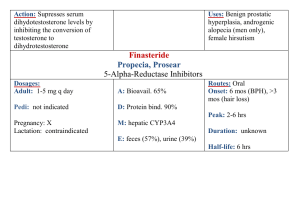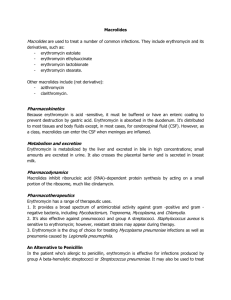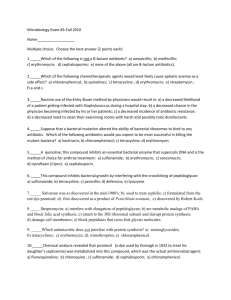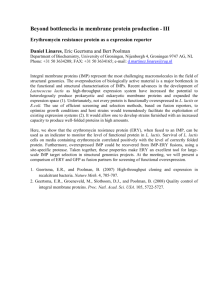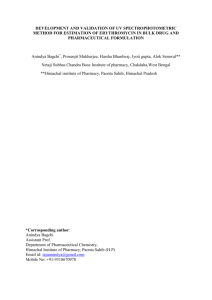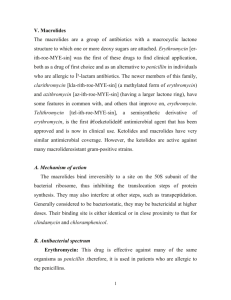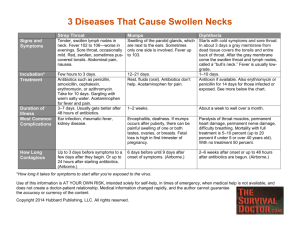Document 13308528
advertisement
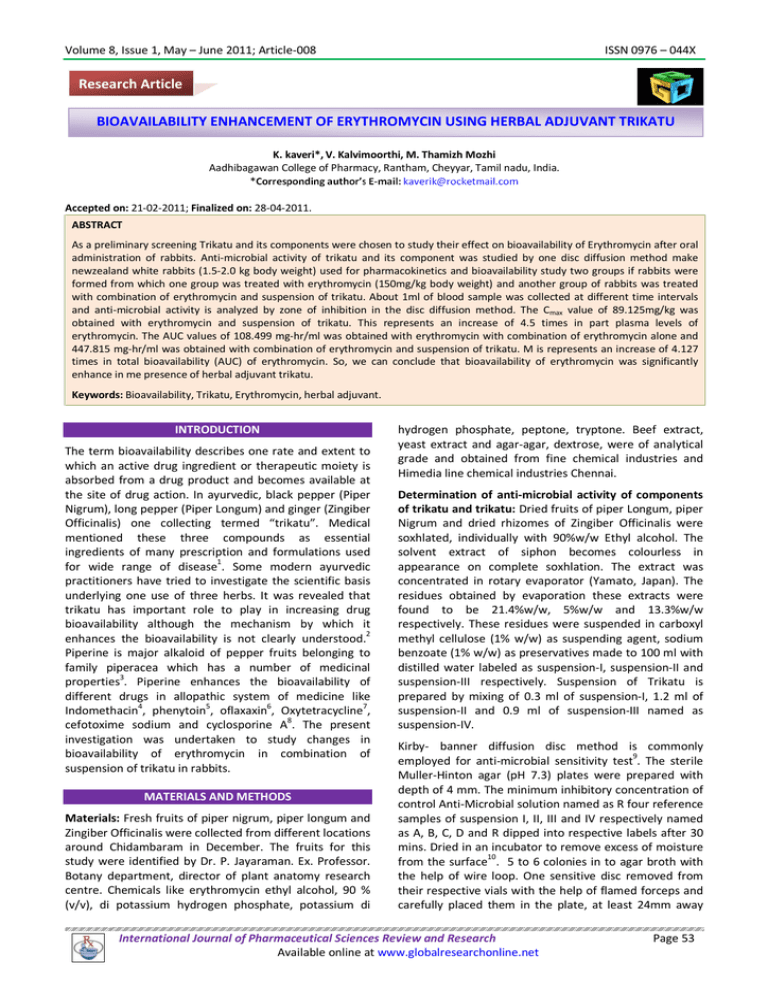
Volume 8, Issue 1, May – June 2011; Article-008 ISSN 0976 – 044X Research Article BIOAVAILABILITY ENHANCEMENT OF ERYTHROMYCIN USING HERBAL ADJUVANT TRIKATU K. kaveri*, V. Kalvimoorthi, M. Thamizh Mozhi Aadhibagawan College of Pharmacy, Rantham, Cheyyar, Tamil nadu, India. Accepted on: 21-02-2011; Finalized on: 28-04-2011. ABSTRACT As a preliminary screening Trikatu and its components were chosen to study their effect on bioavailability of Erythromycin after oral administration of rabbits. Anti-microbial activity of trikatu and its component was studied by one disc diffusion method make newzealand white rabbits (1.5-2.0 kg body weight) used for pharmacokinetics and bioavailability study two groups if rabbits were formed from which one group was treated with erythromycin (150mg/kg body weight) and another group of rabbits was treated with combination of erythromycin and suspension of trikatu. About 1ml of blood sample was collected at different time intervals and anti-microbial activity is analyzed by zone of inhibition in the disc diffusion method. The Cmax value of 89.125mg/kg was obtained with erythromycin and suspension of trikatu. This represents an increase of 4.5 times in part plasma levels of erythromycin. The AUC values of 108.499 mg-hr/ml was obtained with erythromycin with combination of erythromycin alone and 447.815 mg-hr/ml was obtained with combination of erythromycin and suspension of trikatu. M is represents an increase of 4.127 times in total bioavailability (AUC) of erythromycin. So, we can conclude that bioavailability of erythromycin was significantly enhance in me presence of herbal adjuvant trikatu. Keywords: Bioavailability, Trikatu, Erythromycin, herbal adjuvant. INTRODUCTION The term bioavailability describes one rate and extent to which an active drug ingredient or therapeutic moiety is absorbed from a drug product and becomes available at the site of drug action. In ayurvedic, black pepper (Piper Nigrum), long pepper (Piper Longum) and ginger (Zingiber Officinalis) one collecting termed “trikatu”. Medical mentioned these three compounds as essential ingredients of many prescription and formulations used for wide range of disease1. Some modern ayurvedic practitioners have tried to investigate the scientific basis underlying one use of three herbs. It was revealed that trikatu has important role to play in increasing drug bioavailability although the mechanism by which it 2 enhances the bioavailability is not clearly understood. Piperine is major alkaloid of pepper fruits belonging to family piperacea which has a number of medicinal properties3. Piperine enhances the bioavailability of different drugs in allopathic system of medicine like 4 5 6 7 Indomethacin , phenytoin , oflaxaxin , Oxytetracycline , 8 cefotoxime sodium and cyclosporine A . The present investigation was undertaken to study changes in bioavailability of erythromycin in combination of suspension of trikatu in rabbits. MATERIALS AND METHODS Materials: Fresh fruits of piper nigrum, piper longum and Zingiber Officinalis were collected from different locations around Chidambaram in December. The fruits for this study were identified by Dr. P. Jayaraman. Ex. Professor. Botany department, director of plant anatomy research centre. Chemicals like erythromycin ethyl alcohol, 90 % (v/v), di potassium hydrogen phosphate, potassium di hydrogen phosphate, peptone, tryptone. Beef extract, yeast extract and agar-agar, dextrose, were of analytical grade and obtained from fine chemical industries and Himedia line chemical industries Chennai. Determination of anti-microbial activity of components of trikatu and trikatu: Dried fruits of piper Longum, piper Nigrum and dried rhizomes of Zingiber Officinalis were soxhlated, individually with 90%w/w Ethyl alcohol. The solvent extract of siphon becomes colourless in appearance on complete soxhlation. The extract was concentrated in rotary evaporator (Yamato, Japan). The residues obtained by evaporation these extracts were found to be 21.4%w/w, 5%w/w and 13.3%w/w respectively. These residues were suspended in carboxyl methyl cellulose (1% w/w) as suspending agent, sodium benzoate (1% w/w) as preservatives made to 100 ml with distilled water labeled as suspension-I, suspension-II and suspension-III respectively. Suspension of Trikatu is prepared by mixing of 0.3 ml of suspension-I, 1.2 ml of suspension-II and 0.9 ml of suspension-III named as suspension-IV. Kirby- banner diffusion disc method is commonly employed for anti-microbial sensitivity test9. The sterile Muller-Hinton agar (pH 7.3) plates were prepared with depth of 4 mm. The minimum inhibitory concentration of control Anti-Microbial solution named as R four reference samples of suspension I, II, III and IV respectively named as A, B, C, D and R dipped into respective labels after 30 mins. Dried in an incubator to remove excess of moisture from the surface10. 5 to 6 colonies in to agar broth with the help of wire loop. One sensitive disc removed from their respective vials with the help of flamed forceps and carefully placed them in the plate, at least 24mm away International Journal of Pharmaceutical Sciences Review and Research Available online at www.globalresearchonline.net Page 53 Volume 8, Issue 1, May – June 2011; Article-008 ISSN 0976 – 044X from one edge equal distance of placement to avoid overlapping incubated at 37˚C for 16-18 hrs11. Animals used: Healthy male New Zealand white rabbits weighing 1.5-2.0kg and age 4-6months were selected for pharmacokinetic and bioavailability study all rabbits were kept for acclimatization for seven days prior to start pharmacokinetic study. Body weight variation among the animals did not exceed 20% of the mean body weight. The room was environmentally controlled at temperature of 27˚C with relative humidity of 60%. The photo period was 12hrs. Light and 12hrs darkness prescribed feed and add libitum drinking water were provided during experimental period. The experiment was carried out in accordance with the guidelines of institution animal ethics committee. Experimental design: Prior to initiate pharmacokinetic study, animals were tasted over night and the fasting continued up to 4hrs post dosing two groups of rabbits were formed each group having three rabbits. Group-1 was administered erythromycin at dose of 150mg/kg orally, group two received a combination of erythromycin 150mg/kg and trikatu suspension orally and rabbits fed with 120ml water about 1ml of blood was collected from each rabbit at time interval of 0.0, 0.5, 1.0, 1.5, 2.0 and 2.5 hrs. From marginal ear vein with the help of scalp vein set and disposable syringe of 2ml sodium citrate was used as anticoagulant at the rate of 100mg/ml. Preparation of erythromycin standard curve: In this method the growth by erythromycin depends upon the diffusion of antibiotic through solidified agar layer resulting in the development of zone of inhibition around the paper disc containing the solution of erythromycin the medium was prepared autoclaved for sterility in test tubes the plants were inoculated with micrococcus leteus from master culture and incubated at 35-37c for 24hr. from the stock solution of pure samples of erythromycin 50mg/ml. dilutions of 1mg/ml ,2.5mg/ml, 5mg/ml, 7.5mg/ml and 10mg/ml were prepared and labeled A,B,C,D and E as initial solvent and phosphate buffer 6.8pH the disc were prepared by Whatman filter paper, labeled as A,B,C,D and E dipped into respective labels after 30min dried in an incubator to remove excess of moisture. Estimation of erythromycin in blood: The blood sample so collected were stored in 1.5ml plastic tube and centrifuged at 3000rpm at 5min separated blood plasma (0.5ml) was then mixed with methanol (5ml) and vortexes for 10min these samples were left aside for 14min which resulted into separation of plasma and solvent layer. Solvent layer containing respective drug was allowed to evaporate on water bath to have the final volume of 1ml. Samples having erythromycin was analyzed by Kirby banners disc diffusion method from the zone of inhibition concentration of the antibiotic erythromycin was measured by using standard curve of erythromycin. Pharmacokinetic analysis: Pharmacokinetic analysis was carried out using the topfit(V.2) kinetic software peak serum concentration (Tmax) were calculated by least square regression analysis, while elimination half-life (t1/2el) was obtained using the formula t1/2el= 0.693/k el. Area under the serum drug concentration verses time curve (AUC) was calculated by trapezoidal rule. Table 1: Erythromycin Standard Curve S .no 1. 2. 3. 4. 5. Drug dilution (concentration) (µg/ml) 10 7.5 5 2.5 1.0 Concentration (µg/ml) 100 75 50 25 10 Log concentration 2.00 1.875 1.698 1.397 1.000 Zone of inhibition diameter (mm) 15.5 14.5 12.75 9.5 7.75 Table 2: Erythromycin Alone Concentration from Blood Samples Time (hrs) 0.0 0.5 1.0 1.5 2.0 2.5 Zone of inhibition diameter (mm) 0.0 12.0 14.0 15.0 10.0 8.0 ERYTHROMYCIN ALONE Log concentration Concentration (µg/ml) 0.00 0.000 1.550 35.481 1.825 66.834 1.950 89.125 1.300 19.952 1.050 11.220 Bio availability of erythromycin is = International Journal of Pharmaceutical Sciences Review and Research Available online at www.globalresearchonline.net AUC (µg-h/ml) 0.000 25.578 38.989 27.269 7.793 108.499 Page 54 Volume 8, Issue 1, May – June 2011; Article-008 Time (hrs) 0.0 0.5 1.0 1.5 2.0 2.5 ISSN 0976 – 044X Table 3: ERYTHROMYCIN along with TRIKATU Concentration from Blood Samples ERYTHROMYCIN + TRIKATU Zone of inhibition diameter (mm) Log concentration Concentration (µg/ml) AUC (µg-h/ml) 0.0 0.0 0.000 0.00 16.0 2.075 118.850 29.712 19.0 2.475 298.538 104.347 20.0 2.600 398.107 174.161 14.0 1.825 66.834 116.235 11.0 1.425 26.607 23.360 Bio availability of erythromycin is = 447.815 Table 4: Comparative Pharmacokinetic Data of Erythromycin Alone & In Presence of Trikatu Pharmacokinetic Data Erythromycin Erythromycin In Presence of Trikatu Cmax (µg/ml) 89.125 398.107 AUC (µg-h/ml) 108.499 447.815 Tmax(hrs) 1.5 1.5 Kel (ml/h) 0.6086 0.818 T1/2 1.139 0.847 RESULTS AND DISCUSSION The standard curve for erythromycin is prepared from known concentration of erythromycin verses zone of inhibition shown in graph no. 1 different dilution of erythromycin’s zone of inhibition shown in figure-1 the data’s are tabulated in table no-1. Graph 1: Erythromycin Standard Curve The anti-microbial activity of trikatu and its constituents are shown in figure-2 there is no zone of inhibition. So, the trikatu and its constituents don’t having the antimicrobial activity. The concentration of erythromycin obtained from blood samples of rabbit are determined by using standard curve, graph no-2 and graph no-3 shows the concentration of erythromycin alone and its combination with trikatu, values are tabulated in table no-2 and table no-3 respectively. Graph 2: Concentration of Erythromycin Alone From Standard Graph Figure 3 shows zone of inhibition of erythromycin alone and combination with Trikatu. The plasma levels of erythromycin for the different regimens are presented in graph no. 4. A Cmax value of 89.125 mg/ml of 1.5 hrs was achieved when erythromycin was administered alone while Cmax after administration with trikatu suspension was 398.107mg/ml at 1.5 hrs representing an increase of 4.46 times. Other pharmacokinetic parameters comparing the bioavailability of erythromycin alone and combination International Journal of Pharmaceutical Sciences Review and Research Available online at www.globalresearchonline.net Page 55 Volume 8, Issue 1, May – June 2011; Article-008 with trikatu are given in table no-4. The above parameter finding shows that trikatu significantly improve the bioavailability of erythromycin. ISSN 0976 – 044X Figure 1: Zone of Inhibition for Standard Curve Graph 3: Concentration of Erythromycin in Presence of Trikatu from Standard Graph Figure 3: Comparative Zone of Inhibition from Blood Samples Graph 4: Comparison of Mean Plasma Concentration of Erythromycin Alone and With Trikatu International Journal of Pharmaceutical Sciences Review and Research Available online at www.globalresearchonline.net Page 56 Volume 8, Issue 1, May – June 2011; Article-008 Figure 2: Zone Of Inhibition of Trikatu Alone ISSN 0976 – 044X 3. Indian Herbal Pharmacopoeia. Delhi. Government of India, Ministry of Human Resources; 2002. 4. Karan, R.S., Bhargava, V.K.and Garg, S.K.Effect of Trikatu on the Pharmacokinetic Profile of Indomethacin in Rabbits. Indian. J.Pharmacy. 31:1999:160-161. 5. Bano G, Amla, V., Raina, RK.,Zutshi,v. and Chopra,C.L.The Effect of Piperine on Pharmacokinetics of Phenytoin in Healthy Volunteers. Planta Med. 53:1987; 568-569. 6. Zutshi, U. Herbals as Bioenhancer of Bioavailability of Antimicrobials. Ind J.Pharm.17:1985:120-127 7. Results of the present study indicate that trikatu significantly an increase the absorption of erythromycin and retarding its metabolism. So we can conclude that the erythromycin and trikatu combination may result in reduced strength dosage form and also reduced dose dependent side effect. Singh, M.,Varshnaya C., Telang R.S. and Srivastava, A.K. Alteration of Pharmacokinetics Of Oxytetracycline Following Oral Administration of Piper longum in Hens.J.Vet.Sci.6;2005:197-200 8. Sharma P, Varma MV, Chawla HPS and Panchagnula R. In situ and in vivo efficacy of peroral absorption enhancers in rats and correlation to in vitro mechanistic studies. Farmaco. 60: 2005, 874-883. REFERENCES 9. Harbone J.B., Phytochemical methods, 3rd ed, Chapman and Hall, London, 2005, 49-52. CONCLUSION 1. 2. Annamalai R, Manavalan R. Effects of Trikatu and its individual components and piperine on gastrointestinal tract: Trikatu-A bioavailability enhancer. Indian Drugs.27: 1990; 595- 604 Atal CK, Zutshi U, Rao PG. Scientific Evidence on the Role of Ayurvedic Herbals on bioavailability of drugs. Journal of Ethnopharmacology. 4:1981: 229-232. 10. Lala P. K., Practical pharmacognosy, 1, Lina Guha Publication, India 1981, 135-155. 11. Khandelwal K R, Practical pharmacognosy Techniques and Experiments, 16, Nirali Prakashan, India, 2006, 14-165. About Corresponding Author: Mrs. K. Kaveri Mrs. K. Kaveri graduated 1st class and Post graduated with quality assurance from Annamalai University, Chidambaram. Currently working as Asst. prof in Aadhibhagawan College of pharmacy. She is having 6 years of teaching experience, also guiding under graduate pharmacy students. International Journal of Pharmaceutical Sciences Review and Research Available online at www.globalresearchonline.net Page 57
